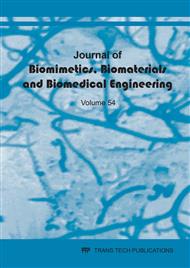[1]
Scarano, M. Degidi, G. Iezzi, G. Petrone, A. Piattelli, Correlation between implant stability quotient and bone-implant contact: a retrospective histological and Histomorphometrical study of seven titanium implants retrieved from humans, Clin Implant Dent Relat Res. (2006) 218-22.
DOI: 10.1111/j.1708-8208.2006.00022.x
Google Scholar
[2]
V. Mathieu, R. Vayron, G. Richard, G. Lambert, S. Naili, J. Meningaud, G. Haiat, Biomechanical determinants of the stability of dental implants: influence of the bone–implant interface properties, J Biomech. (2014) 3-13.
DOI: 10.1016/j.jbiomech.2013.09.021
Google Scholar
[3]
M. Pirmoradian, H. Ajabi Naeeni, M. Firouzbakht, D. Toghraie, M. Khaje khabaz, R. Darabi, Finite element analysis and experimental evaluation on stress distribution and sensitivity of dental implants to assess optimum length and thread pitch, Computer Methods and Programs in Biomedicine. (2019).
DOI: 10.1016/j.cmpb.2019.105258
Google Scholar
[4]
E. Orsini, S. Salgarello, M. Bubalo, Z. Lazic, A. Trire, D. Martini, M. Franchi, A. Ruggeri, Histomorphometric evaluation of implant design as a key factor in periimplant bone response: a preliminary study in a dog model, Minerva stomatologica. (2009) 263-275.
Google Scholar
[5]
G. Yang, F. He, X. Yang, X. Wang, S. Zhao, Bone responses to titanium implants surface-roughened by sandblasted and double etched treatments in a rabbit model, Oral Surg Oral Med Oral Pathol Oral Radiol Endod. (2008) 1-9.
DOI: 10.1016/j.tripleo.2008.03.017
Google Scholar
[6]
L. Huang, J. Shotwell, H. Wang, Dental implants for orthodontic anchorage, Am J Orthod Dentofacial Orthop. (2005) 713-722.
DOI: 10.1016/j.ajodo.2004.02.019
Google Scholar
[7]
L. Guehennec, A. Soueidan, P. Layrolle, Y. Amouriq, Surface treatments of titanium dental implants for rapid osseointegration, Dent Mater. (2007) 844-854.
DOI: 10.1016/j.dental.2006.06.025
Google Scholar
[8]
J. Ivanoff, J. Sennerby, C. Johansson, B. Rangert, U. Lekholm, Influence of implant diameter on integration of screw implants, An experimental study in rabbits, Int J Oral Maxillofac Surg. (1997) 141-148.
DOI: 10.1016/s0901-5027(05)80837-9
Google Scholar
[9]
M. Akkocaoglu, S. Uysal, I. Tekdemir, K. Akca, M. Cehreli, Implant design and intraosseous stability of immediately placed implants: a human cadaver study, Clin Oral Implants Res. (2004) 202-209.
DOI: 10.1111/j.1600-0501.2004.01099.x
Google Scholar
[10]
L. Vidyasagar, P. Apse, Dental implant design and biological effects on bone-implant interface, Baltic Dent Maxillofac J. (2004) 51-54.
Google Scholar
[11]
S. Vandeweghe, J. Cosyn, E. Thevissen, J. Teerlinck, H. De-Bruyn, The influence of implant design on bone remodeling around surface‐modified Southern Implants, Clinical Implant Dentistry and Related Research. (2012) 655-662.
DOI: 10.1111/j.1708-8208.2010.00308.x
Google Scholar
[12]
H. Abuhussein, G. Pagni, A. Rebaudi, H. Wang, The effect of thread pattern upon implant osseointegration, Clinical Oral Implants Research. (2010) 129-136.
DOI: 10.1111/j.1600-0501.2009.01800.x
Google Scholar
[13]
M. Herekar, N. Patil, S. Mulani, M. Sethi, O. Padhye, The influence of thread geometry on biomechanical load transfer to bone: A finite element analysis comparing two implant thread designs, Dental Research Journal. (2014) 489-494.
Google Scholar
[14]
M. Oswal, U. Amasi, M. Oswal, A. Bhagat, Influence of three different implant thread designs on stress distribution: A three‐dimensional finite element analysis, Journal of Indian Prosthodontic Society. (2016) 359-365.
DOI: 10.4103/0972-4052.191283
Google Scholar
[15]
W. Kleis, P. Kämmerer, S. Hartmann, B. Al-Nawas, W. Wagner, A comparison of three different attachment systems for mandibular two-implant overdentures: one-year report, Clin, Implant Dent,Relat,Res. (2010) 209-218.
DOI: 10.1111/j.1708-8208.2009.00154.x
Google Scholar
[16]
Cunha, A. Freitas, M. Marquezan, L. Nojima, Mechanical influence of thread pitch on orthodontic mini-implant stability, Braz Oral Res. (2015) 1-6.
DOI: 10.1590/1807-3107bor-2015.vol29.0042
Google Scholar
[17]
U. Chaiwat, R. Pimduen, R. Chaiy, K. Pathawee, Comparative study of stress characteristics in surrounding bone during insertion of dental implants of three different thread designs: A three‐dimensional dynamic finite element study, Clin Exp Dent Res. (2018) 1-12.
DOI: 10.1002/cre2.152
Google Scholar
[18]
N. Djebbar, B. Serier, B. Bachir-Bouiadjra, S. Benbarek, A. Drai, Analysis of the effect of load direction on the stress distribution in dental implant, Materials and Design. (2010) 2097–2101.
DOI: 10.1016/j.matdes.2009.10.042
Google Scholar
[19]
N. Djebbar, B. Serier, B. Bachir-Bouiadjra, Finite element analysis in static and dynamic behaviors of dental prosthesis, Structural Engineering and Mechanics. (2015) 65-78.
DOI: 10.12989/sem.2015.55.1.065
Google Scholar
[20]
N. Djebbar, B. Serier, B. Bachir-Bouiadjra, Stress Distribution of the Variable Dynamic Loading in the Dental Implant: A Three-Dimensional Finite Element Analysis, Journal of Biomimetics, Biomaterials and Biomedical Engineering. (2017) 44-52.
DOI: 10.4028/www.scientific.net/jbbbe.31.44
Google Scholar
[21]
Ching Lee, S. Chih Lin, K. Ming-Jen, W. Shu-Wei, Ping-Yuen F, Effects of implant threads on the contact area and stress distribution of marginal bone, J Dent Sci. (2010) 156-165.
Google Scholar
[22]
M. Pirmoradian, H. Naeeni, M. Firouzbakht, D. Toghraie, M. khabaz, R. Darabi, Finite element analysis and experimental evaluation on stress distribution and sensitivity of dental implants to assess optimum length and thread pitch. Computer Methods and Programs in Biomedicine, (2019).
DOI: 10.1016/j.cmpb.2019.105258
Google Scholar
[23]
J. Steigenga, K. Al-Shammari, C. Misch, F. Nociti, H. Wang, Effects of implant thread geometry on percentage of osseointegration and resistance to reverse torque in the tibia of rabbits, Journal of Periodontol. (2004) 1233-1241.
DOI: 10.1902/jop.2004.75.9.1233
Google Scholar
[24]
J. Geng, Q. Ma, W. Xu, K. Tan, G. Liu, Finite element analysis of four thread-form configurations in a stepped screw implant. Journal of Oral Rehabil (2004) 233-239.
DOI: 10.1046/j.0305-182x.2003.01213.x
Google Scholar
[25]
H. Chun, S. Cheong, J. Han, S. Heo, J. Chung, I. Rhyu, Y. Choi, K. Baik, Y. Ku, M. Kim, Evaluation of design parameters of osseointegrated dental implants using finite element analysis, Journal of Oral Rehabil. (2002) 565-574.
DOI: 10.1046/j.1365-2842.2002.00891.x
Google Scholar


